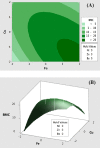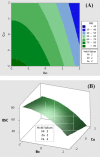Plackett-Burman Design and Response Surface Optimization of Medium Trace Nutrients for Glycolipopeptide Biosurfactant Production
- PMID: 28433004
- PMCID: PMC5459940
- DOI: 10.18869/acadpub.ibj.21.4.249
Plackett-Burman Design and Response Surface Optimization of Medium Trace Nutrients for Glycolipopeptide Biosurfactant Production
Abstract
Background: A glycolipopeptide biosurfactant produced by Pseudomonas aeruginosa strain IKW1 reduced the surface tension of fermentation broth from 71.31 to 24.62 dynes/cm at a critical micelle concentration of 20.80 mg/L. The compound proved suitable for applications in emulsion stabilization in food, as well as in cosmetic and pharmaceutical formulations.
Method: In the present study, Plackett-Burman design (PBD) and response surface method (RSM) were employed to screen and optimize concentrations of trace nutrients in the fermentation medium, to increase surfactant yield.
Results: The PBD selected 5 out of the 12 screened significant trace nutrients. The RSM, on the other hand, resulted in the production of 84.44 g glycolipopeptide/L in the optimized medium containing 1.25 mg/L nickel, 0.125 mg/L zinc, 0.075 mg/L iron, 0.0104 mg/L boron, and 0.025 mg/L copper.
Conclusion: Significant second-order quadratic models for biomass (P<0.05; adjusted R2=94.29%) and biosurfactant (R2=99.44%) responses suggest excellent goodness-of-fit of the models. However, their respective non-significant lack-of-fit (Biomass: F=1.28; P=0.418; Biosurfactant: F=1.20; P=0.446) test results indicate their adequacy to explain data variations in the experimental region. The glycolipopeptide is recommended for the formulation of inexpensive pharmaceutical products that require surface-active compounds.
Keywords: Pseudomonas aeruginosa; Surface-active agents; Fermentation; Nickel; Copper.
Conflict of interest statement
Figures






References
-
- Abouseoud M, Maachi R, Amrane A, Boudergua S, Nabi A. Evaluation of different carbon and nitrogen sources in production of biosurfactant by Pseudomonas fluorescens. Desalination. 2008;223(1-3):143–151.
-
- Banat IM, Franzetti A, Gandolfi I, Bestetti G, Martinotti M G, Fracchia L, Smyth TJ, Marchant R. Microbial biosurfactants production, applications and future potential. Applied microbiology and biotechnology. 2010;87(2):427–444. - PubMed
LinkOut - more resources
Full Text Sources
